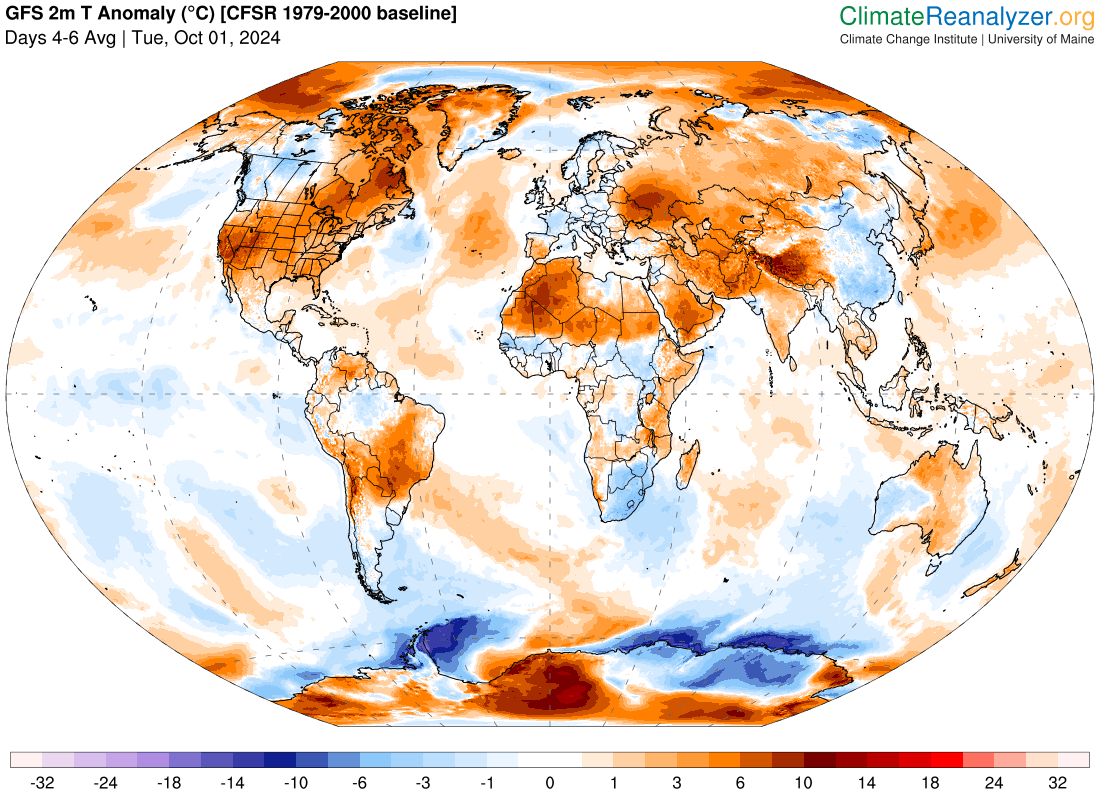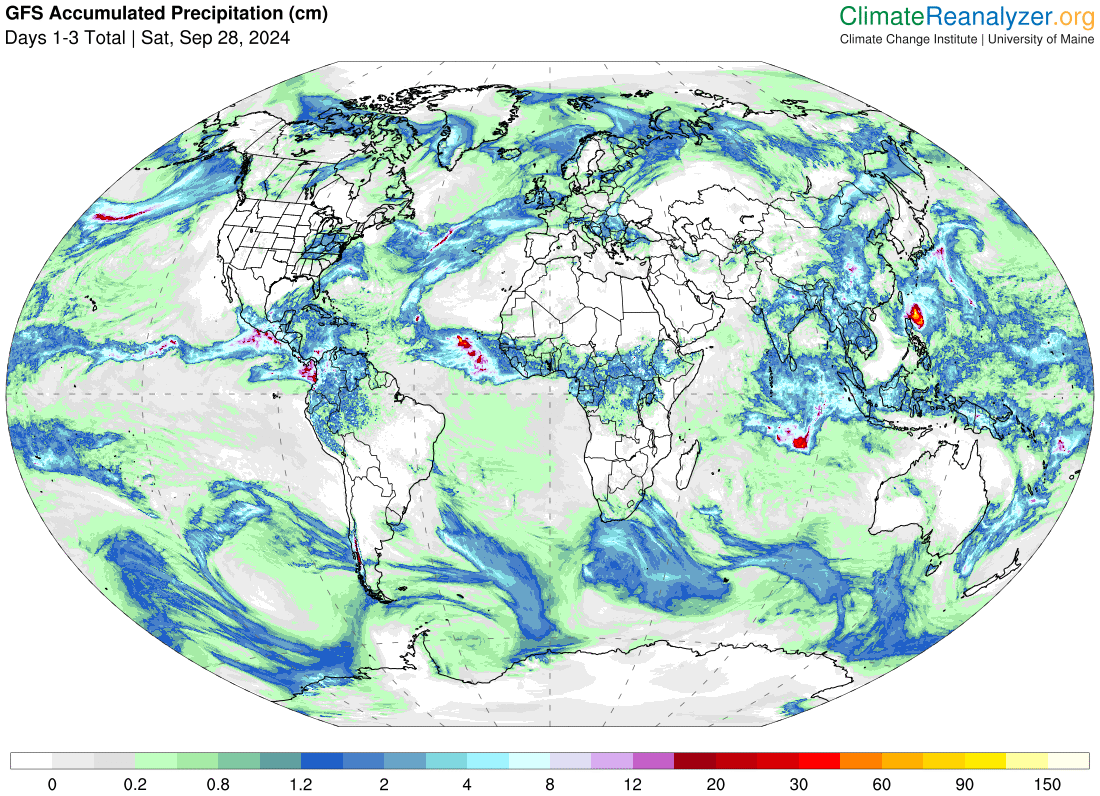Here is what we are paying attention to in the next 48 to 72 hours. The article also includes weather maps for longer-term outlooks and a six-day World weather outlook.
We start with the U.S. Information. You can update this section here but these are 48 to 72-hour forecasts so if I have not been able to update this area twice daily, what is shown is still valid and the images in the body of the article update automatically but sometimes they are a bit slow to update.
Short Range Forecast Discussion
NWS Weather Prediction Center College Park MD
400 PM EDT Fri Sep 22 2023
Valid 00Z Sat Sep 23 2023 – 00Z Mon Sep 25 2023…Tropical Storm Ophelia is forecast to make landfall over eastern North
Carolina early on Saturday, bringing squally heavy rain, threat of flash
flooding farther inland, and storm surge to coastal communities up the
Mid-Atlantic states……Bouts of strong to severe thunderstorms are expected to impact portions
of the central U.S., including chances for excessive rainfall……Summer heat continues across portions of the southern Plains, while
much cooler temperatures begin to moderate throughout the Intermountain
West and northern Rockies…

![[Key Messages]](https://www.nhc.noaa.gov/storm_graphics/AT16/refresh/AL162023_key_messages+png/024246_key_messages_sm.png)
| Notices: We just published the new NOAA Seasonal Outlook and you can access that report HERE. |
First, the 48-Hour Forecast (It is a 48 to 72 Hour Forecast actually)
Daily weather maps. The Day 1 map updates twice a day and the Day 2 and 3 maps update only once a day. These maps update automatically. But if that does not happen, you can get updates by clicking HERE
TODAY (or late in the day the evening/overnight map will appear)
TOMORROW
NEXT DAY
This animation shows how things may play out over the next 60 hours. To update click here.
The NWS Climate Prediction Center’s: Watches, Warnings, and Advisories plus other information can be found HERE. We post at least one of those updates daily, sometimes both. The Highlights are shown in the lede paragraph of this article.
ATMOSPHERIC RIVERS
This tells us what is approaching the West Coast. Click HERE to update If I have not gotten around to doing the update. Here is some useful information about Atmospheric Rivers.
Continuation of the NWS Short Range Forecast. It is updated by NWS twice a day and these updates can be found here
The National Hurricane Center has upgraded the developing low pressure
system off the coast of the southeastern U.S. to Tropical Storm Ophelia
early this afternoon. Tropical-storm-force winds associated with Ophelia
is more expansive than an ordinary tropical storm as the core of the
system moves generally northward over the warm waters off the Carolina
coasts through tonight, while undergoing continued interaction with a
frontal boundary and a cool upper trough sliding off the southeast U.S. A
dreary and windy weekend is in store for much of the Mid-Atlantic
especially along the coast where the full force of the
tropical-storm-force winds will be felt. Coastal flooding due to storm
surge will become an increasing concern as tonight progresses and
especially along the coast of the eastern half of North Carolina early on
Saturday when Ophelia is expected to be the strongest as it makes
landfall. Meanwhile, the strongest upper-level dynamics associated with
Ophelia is forecast to dump the heaviest rains to the north and northwest
of the circulation center–from much of the Mid-Atlantic and eventually up
into southern New England, creating the potential for scattered flash
floods and isolated urban and small stream flooding. The greatest risk
for several inches of rainfall will most likely be near and just west of
the storm track from North Carolina into southeastern Virginia, across
eastern Maryland and Delaware, and then across southern New Jersey. By
Sunday, Ophelia is forecast to become much weaker as it inches northward
over the Chesapeake Bay and the Delmarva Peninsula and gradually lose
tropical characteristics. Some additional heavy rainfall may linger from
the northern Mid-Atlantic to southern New England, with continued strong
and gusty east-northeasterly flow along coastal regions.Throughout the central U.S., a potent system ejecting out of the Rockies
and coming to a crawl over the Mississippi Valley this weekend is
anticipated to trigger widespread shower and thunderstorm chances. Some
storms may turn severe into tonight across the northern and central High
Plains, with the severe threat becoming more widespread on Saturday from
the Middle Missouri Valley to the Southern Plains near and ahead of an
elongated low pressure system. Heavy rain is also possible on the
northern quadrant of this storm system through tonight across the northern
Plains before shifting east and southeast, overlapping with the severe
weather threat area on Saturday. Some repeating rounds of thunderstorms
could produce a few inches of rainfall within a short period of time,
leading to scattered flash flooding concerns. Meanwhile, high-elevation
wet snow over northwestern Wyoming on the back-side of this system is
forecast to taper off by Saturday morning.The temperature outlook for the final full weekend of September is
highlighted by below average temperatures across the Mid-Atlantic,
Northeast, and western third of the Nation. In fact, conditions are likely
to be cold enough over the northern Rockies to produce snow across the
highest elevations. Elsewhere, summer continues to hang on across the
southern Plains as above average temperatures and highs into the upper 90s
remain in the forecast. Afternoon temperatures should peak in the low 100s
along the U.S.-Mexico border. Thankfully, looking further ahead, a cold
front approaching by the end of the weekend is expected to knock
temperatures closer to average by Monday, with only South Texas likely
remaining well above average.
Learn about wave patterns HERE.
Below is the current five-day cumulative forecast of precipitation (Updates can be found HERE)
Now we look at Intermediate-Term “Outlook” maps for three time periods. Days 6 – 10, Days 8 – 14, and Weeks 3 and 4. An outlook differs from a forecast based on how NOAA uses these terms in that an “outlook” presents information as deviation from normal and the likelihood of these deviations.
Below are the links to obtain updates and additional information. They are particularly useful if you happen to be reading this article significantly later than when it was published. I always try to provide readers with the source of the information in my articles.
| Days 6 – 10 (shown in Row 1) | Days 8 – 14 (Shown in Row 2) | Weeks 3 and 4 (Shown in Row 3 but updates only on Fridays) |
| https://www.cpc.ncep.noaa. gov/products/predictions/610day/ | https://www.cpc.ncep .noaa.gov/products/predictions/814day/ | https://www.cpc.ncep.noaa.gov/products/predictions/WK34/ |
Showing the actual maps. They should now update automatically. The Week 3 – 4 Outlook only updates on Fridays. So below is what I call the Intermediate-term outlook. On Fridays, it extends out 28 Days. That declines day by day so on Thursday it only looks out 22 days until the next day when the Week 3 – 4 Outlook is updated and this extends the outlook by one additional week.
| 6–
10
|
|
|
| 8–
14 |
|
|
| 3–
4 |
|
|
HAZARDS OUTLOOKS
Click here for the latest complete Day 3 -7 Hazards forecast which updates only on weekdays. Once a week probably Monday or Tuesday I will update the images. I provided the link for readers to get daily updates on weekdays. Use your own judgment to decide if you need to update these images. I update almost all the images Friday Night for the weekend edition of this Weather Report. So normally readers do not need to update these images but if the weather is changing quickly you may want to.
Temperature month to date can be found at https://hprcc.unl.edu/products/maps/acis/MonthTDeptUS.png
Precipitation month to date can be found at https://hprcc.unl.edu/products/maps/acis /MonthPNormUS.png
World Forecast
Below are the Day 1 -3 and 4-6 forecasts for temperature and precipitation. Updates and much additional information can be obtained HERE
World Temperature Anomalies

World Accumulated Precipitation

This information is provided by the University of Maine. They draw upon many different sources. There is a lot of information available at the link provided. I have just provided two useful forecasts. There are probably over a hundred different forecasts available from this source.
Worldwide Tropical Forecast (This is a NOAA Product)
This graphic updates on Tuesdays) If it has not been updated, you can get the update by clicking here Readers will only have to do that if they are reading this article much later than the date of it being published.
Information on Tropical Storms can be found HERE. Western Pacific information can be found HERE.

–
| I hope you found this article interesting and useful. |
–


